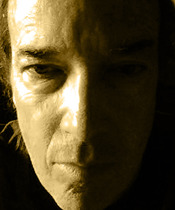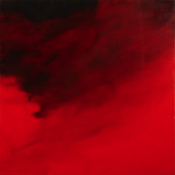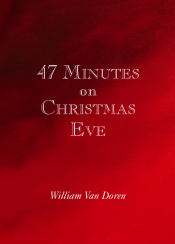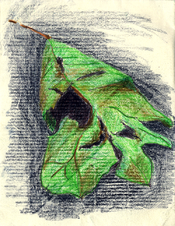 William Theodore Van Doren. Sunset from Stony Point, Albemarle County, Va. Oil on watercolor block, 16 x 20.
William Theodore Van Doren. Sunset from Stony Point, Albemarle County, Va. Oil on watercolor block, 16 x 20.
Out on a very wet seven-mile ramble with Flint the pound-found foxhound, even in, or especially in, the gray light I was seeing so many colors. (Flint meanwhile was more than doubling my mileage, chasing things I never saw and I’m not sure he saw, either.) Standing in the lonesome part of this place we call Abandon Alley – a wide swath of power line where you can see at least a mile of cut-over nothing in particular – with woods ranged along either side of a long, stepped descent to the river and an equally long rise to a blue-green field on the opposite height (strange, almost the exact color of oats in midsummer), I realized that if I were to try to name all the color variations I was seeing, it would go on forever – and I wouldn’t mind. Just naming variations on green and yellow would be enough – poplar yellow (or maybe that should be yellow poplar yellow), cedar green, distant patches sort of brown but actually dried weeds of a pinkish gold, and just at hand, clinging on a swaying head of deep goldenrod, a pale yellow moth. And so on.
But the best color encounter came later, in the middle of the woods. In that peculiar, even light of clouds and rain, I was stumped by the turning dogwood leaves – not yet the dark scarlet of mid-autumn, some were still green and some – a delicate shade of orange I realized I couldn’t describe. Couldn’t describe it then and I know I can’t describe it now without a little imaginative assistance from you. A fresh new bright pale orange with a subtle overtone of red and an undertone of something like cream. How was this happening?
I finally took a leaf – in fact, I ended up taking two, to look at a deeper variation on the theme. (To many native Virginians, although it’s – just – O.K. to take a dogwood leaf, if you break a branch or, God forbid, kill a tree ... you only hope nobody finds out.) And so I found the reason for my difficulty. On one side, the side that had been facing the light, each leaf was turning the familiar russet and almost violet red. But on the underside – still not penetrated with the red, the side facing me was a flat, neutral, almost colorless green. The effect was composite, from backlighted screens of scarlet and green. No wonder I couldn’t put a name to it. I do know that if they made a candy that soft orange color – like maybe a tropical fruit–flavored variety of Chuckles – it would be irresistible.
Rain all day – might have to turn the sky over to find the colors.





 Wednesday, November 18, 2009 at 01:56PM
Wednesday, November 18, 2009 at 01:56PM



Sunset, Wednesday, 7 October 2009
I happen to be very fond of vacant lots. Today I walked across this county’s mother of all vacant lot regions, the semi-developed territories on the perimeter of the so-called Hollymead Town Center, an interesting name for a shopping center where there is neither a town nor anything resembling a center. The sprawling mess, in the inimitable signature style of its developer, appears to have been not so much designed as randomly bulldozed.
So maybe I should clarify by saying that while I hate the process that creates vacant lots, I love the places themselves. At the center's northern limit, as I was about to enter this unnatural park, I stopped to sketch a beautiful old pear tree (real pear, not a decorative barren Bradford). Then I was amazed, as many times as I’ve driven into the place, to scale the eroded gravel banks along the northern entrance and find, largely hidden from the view of cars, acres of unfinished foundations and cement walls, gravel, weeds, straw strewn (a bit late) to slow the growth of gullies, overgrown backhoe attachments, lonely turquoise-painted utility connection pipes, a fuel tank, a dumpster, that lovely webbed orange plastic fencing and, scattered everywhere like enemy bunkers dislodged out of the ground by heavy bombardment, storm drains ready to be installed RIGHT NOW in front of YOUR store or office. Or maybe you have some heavy equipment capable of hoisting them into your half-ton pickup (might fit) and plopping them into your front yard, where you could enjoy having your very own storm drain complete with iron manhole cover. No hurry, they’ve got plenty.
Anyway, as negative as I may sound about these landscapes, in a strange way I love them all. As long as a vacant lot remains a vacant lot, to me it’s a wild place. It almost seems wilder than a preserve, because of the sense that it’s holding off a process of loss – it’s winning, for the moment. There’s a sense of intermission, of remission, of stillness and calm made greater by the agitation that presses against it. Anything can happen. And because of the way we live, and the way we drive around, and almost never go on foot in certain places, when you walk in some of these lands you may legitimately feel as though you’re its true discoverer and explorer. For me, I think this tends to fulfill the naive notion I had as a child that I was the first person ever to see a certain wonderful tree in the woods, or beautiful cascade on the local stream – certainly I wasn’t, but I might be the first person crazy enough to walk along the top of a certain ridge of excavated dirt.
The pear tree stands at the corner of a field of wild brown grasses and weeds, bordered by a strip mall, a ‘self-storage’ facility, a bank, an auto repair shop, and a quasi-colonial brick building that was once an independent grocery, then a Salvation Army Thrift Store, and is now for sale. The tree, the field, and some woods beyond, are probably all doomed. But as long as they live, they live forever.